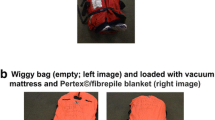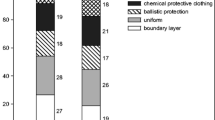Abstract
A chemical warfare (CW) protective bag for babies, younger than 1 year, has been evaluated in respect of thermal load. Heat and water vapour dissipating from the baby make the climate in the protective bag more demanding than outside. The thermal strain on a baby was estimated from heat and mass transfer data using an electrically heated baby manikin and a water-filled tray. Furthermore, a theoretical baby model was developed based on relations valid for heat and mass transfer rates from a cylinder and flat surface. Convective and radiative (dry) and evaporative heat transfer coefficients calculated from this model agreed well with the measured values. The maximum heat dissipation from a baby was calculated for combinations of air temperatures (22–30°C) and relative humidities (70–90% rh). The results indicate that a naked baby can dissipate about 100% more heat than is produced during basal conditions when the bag is ventilated (70 l min−1) and the ambient climate is 30°C and 90% rh. If the ventilation rate is 40 l min−1, the margin is reduced to 50%. Clothing reduces the margin further. Ventilating the bag with 70 l min−1, a dressed baby can dissipate only 10–20% more heat than is produced during basal conditions in a climate (27°C and 80% rh) that is obtained in a crowded shelter after about 24 h of occupation.


Similar content being viewed by others
References
Kakitsuba N, Bondi KR (1987) Heat transfer from human body in hyperthermic, low gas-velocity environments. Aviat Space Environ Med 58:227–236
McLean JA, Tobin G (1987) Animal and human calorimetry. Cambridge University Press, Cambridge, UK
Wheldon A E (1982) Energy balance in a newborn baby: use of a manikin to estimate radiant and convective heat loss. Phys Med Biol 27:285–296
Author information
Authors and Affiliations
Corresponding author
Rights and permissions
About this article
Cite this article
Danielsson, U. Heat and mass transfer from a baby manikin: impact of a chemical warfare protective bag. Eur J Appl Physiol 92, 689–693 (2004). https://doi.org/10.1007/s00421-004-1133-2
Accepted:
Published:
Issue Date:
DOI: https://doi.org/10.1007/s00421-004-1133-2




